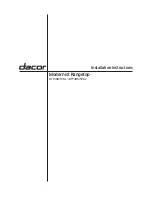
41
Gas connection
Before connecting the gas supply, make sure that the local distribution conditions (type and pressure of gas) and the adjustment of
the appliance are compatible. The appliance adjustment conditions are indicated on the data plate on the underside.
The appliance input consists of a gas ramp with the end facing sideways, to simplify installation.
The end is cylindrical,
8 mm diameter
, unthreaded, for at least 30 mm. Where permitted by the installation standards in force,
connection to the gas main may take place using a flexi-pipe with a gas-proof press fitting (complete with ogive).
In the specific case of built-in installation, UNI 7131 forbids direct connection of the appliance to the gas bottle by flexi-pipe. It is
therefore necessary to connect the appliance to a fixed system (UNI 7129), which will be connected to the gas bottle and the
appliance by flexi-pipes (UNI 7140) with a rubber insert support and relative clamps (UNI 7141). The flexi-pipe must have a
maximum length of 1.5 m, without intermediate joints, and must not run through two different rooms.
The connections must not
cause the pipe to twist, bend or be crushed and the pipe must not come into contact with sharp items or edges and must not
exceed a temperature of 50°C. The flexi-pipe and relative rubber insert support must be open to inspection.
The regulator fitted to the gas bottle must be compliant with EN 12864.
To make the flexi-pipe of the appliance suitable for connection, use a rubber insert support compliant with UNI 7141, with relative
clamps, at the appliance end. It is necessary to use an adapter for this (if not supplied with the appliance, ask Technical
Assistance for one). This adapter will be connected to the smooth end of the appliance by a gas-proof press fitting and connected
to the rubber insert support by a threaded connection (compliant with ISO 7-1 if the rubber insert holder is not supplied with the
appliance). Pay attention to the marking of the threading on the adapter: check that it is compatible with that of the rubber insert
support.
Upon completion of installation, check the seal of the connection in compliance with the methods indicated by the legislation in
force. Never use a naked flame.
Checking the correct operation of the burners
When the appliance is installed, check that all the burners work properly.
Check the ignition, in compliance with the Instructions for Use section, the stability of the flame, the maintenance of the flame
when turning the knob from maximum to minimum. The flame must not flare up or go out.
If this happens:
-
check the type of gas/pressure used: it must correspond to that indicated on the appliance plate;
-
check for any shifting of the burner parts (flame divider, cap), due to assembly of the appliance.
If the problem persists, contact Technical Assistance.
Ventilation
This appliance is not connected to a device for the evacuation of the combust products. Therefore, it must be connected in
compliance with the installation standards in force. Pay particular attention to that envisaged by local legislation on the matter of
ventilation ad aeration.
Specifically (UNI 7131), the room where the appliance is installed:
-
must be fitted with a system to take the combustion fumes outside, through a hood or electric fan which starts operating
automatically every time the appliance is switched on;
-
it must have a system which allows the air flow necessary for proper combustion (at least 2 m
3
/h for each kW of installed
power). This can be obtained by taking the air directly from outside (section of at least 100 cm
2
, in order to prevent it
becoming accidentally blocked), or indirectly from adjacent rooms (not bedrooms or rooms where there is a risk of
explosion) which are directly ventilated and connected to the former by permanent openings.
The appliance is fed by LPG (liquid petroleum gas).
LPG is heavier than air, so it settles downwards. Consequently LPG bottles must have an opening towards the outside to allow
low-level evacuation of any gas leaks.
Empty r partially full LPG bottles must not be installed or kept in rooms or
areas that are below ground level (cellars, etc.).
Only gas bottles that are being used may be kept in said rooms/areas, in a position where they are not subject to the direct action
of sources of heat (50°C).
Adjustments and transformations
No adjustment is necessary:
-
the burners are fixed primary air burners;
-
as the only power supply is LPG (in compliance with that indicated on the plate on the underside of the appliance), the
minimum levels have already been set in the factory. The valve by-pass screw has already been fully tightened. Should an
inadequate flame be found in the Minimum position during use, intervention on the by-pass valve screw is forbidden. Check
Summary of Contents for PC Series
Page 1: ...MANUAL INSTRUCCTION PC series FC series FN series PVseries...
Page 45: ...45...
Page 46: ...46...
Page 47: ...47...








































